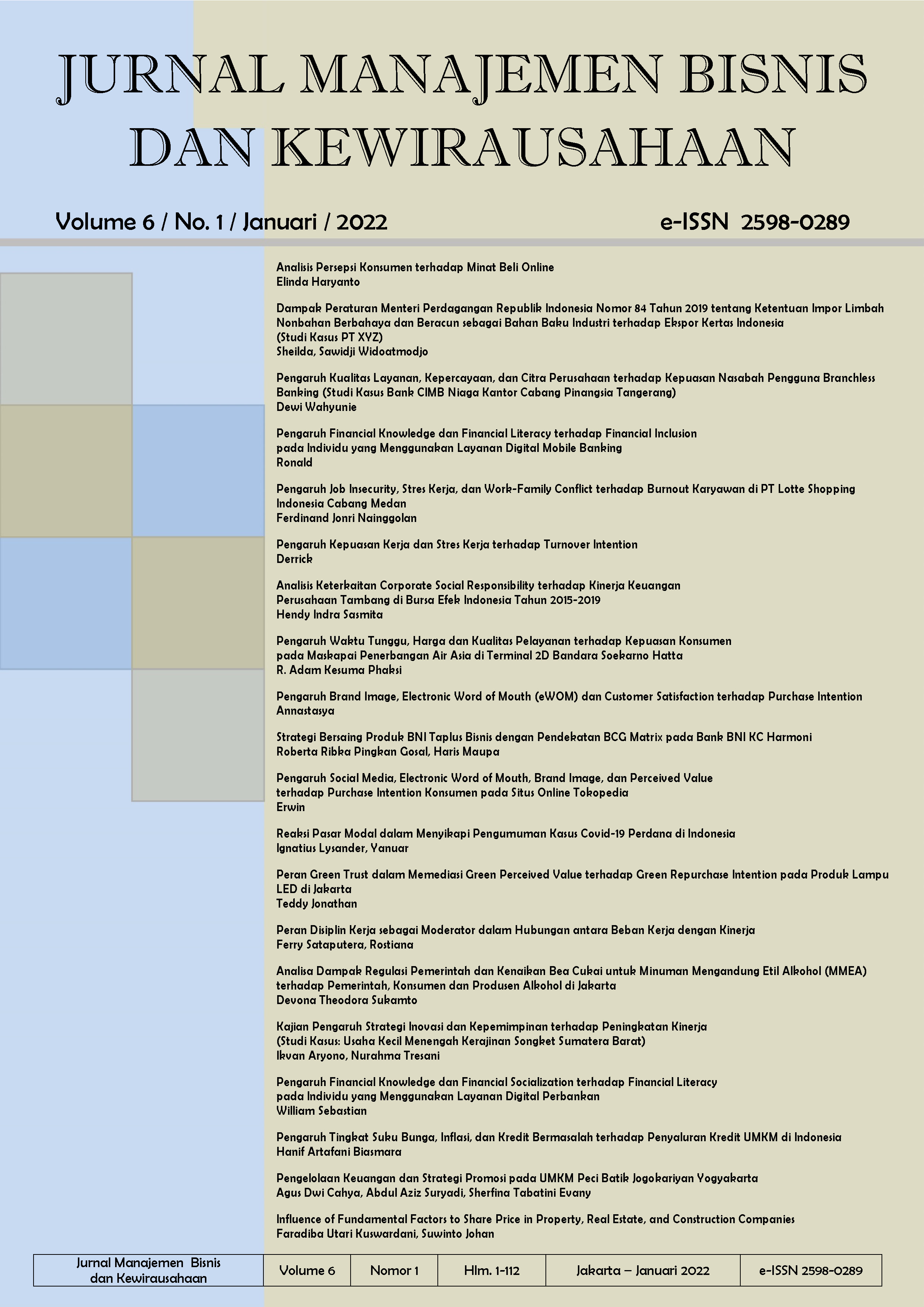Pengaruh Financial Knowledge dan Financial Socialization terhadap Financial Literacy pada Individu yang Menggunakan Layanan Digital Perbankan
Main Article Content
Abstract
The purpose of this research is to examine the effect of financial knowledge and financial socialization on financial literacy. This study uses 414 samples, consisting of parties who use the digital banking system mobile banking in DKI Jakarta. A partial least square was applied to analyze the association of financial knowledge and financial literacy with financial socialization as the mediation variable. This study reveals a direct effect of financial knowledge on financial literacy. But financial socialization has no significant impact on financial literacy. This study provides input for the Indonesian people to encourage investment intentions for investors and potential investors in using mobile banking services so that investment in mutual funds will be easier and increase. This research is an outreach for investors and potential investors to use mobile banking in investing in finance in Indonesia.
Tujuan penelitian ini adalah untuk menguji pengaruh pengetahuan keuangan dan sosialisasi keuangan terhadap literasi keuangan. Penelitian ini menggunakan 414 sampel yang terdiri dari pihak-pihak yang menggunakan sistem perbankan digital mobile banking di DKI Jakarta. Partial Least Square digunakan untuk menganalisis hubungan antara pengetahuan keuangan dan literasi keuangan dengan sosialisasi keuangan sebagai variabel mediasi. Studi ini mengungkapkan pengaruh langsung pengetahuan keuangan terhadap literasi keuangan. Namun sosialisasi keuangan tidak berpengaruh signifikan terhadap literasi keuangan. Penelitian ini memberikan masukan bagi masyarakat Indonesia untuk mendorong niat berinvestasi bagi investor dan calon investor dalam menggunakan layanan mobile banking agar investasi pada reksa dana semakin mudah dan meningkat. Penelitian ini bertujuan untuk menjangkau investor dan calon investor untuk menggunakan mobile banking dalam berinvestasi di bidang keuangan di Indonesia.
Article Details
This work is licensed under a Jurnal Manajemen Bisnis dan Kewirausahaan Creative Commons Attribution-ShareAlike 4.0 International License.
References
Alika, R. (2020). Literasi keuangan digital rendah, Jokowi minta fintech perluas peran. KataData. https://katadata.co.id/ameidyonasution/berita/5fac4a1893be8/literasi-keuangan-digital-rendah-jokowi-minta-fintech-perluas-peran
Atkinson, A., & Messy, F.-A. (2012). Measuring financial literacy: Results of the OECD INFE pilot study. In OECD Working Papers on Finance, Insurance and Private Pensions (Issue 15). https://doi.org/10.1787/bb2cd70c-en
Bhushan, P., & Medury, Y. (2014). An empirical analysis of inter linkages between financial attitudes, financial behaviour and financial knowledge of salaried individuals. Indian Journal of Commerce & Management Studies, 5(3), 1161–1201. http://www.scholarshub.net/index.php/ijcms/article/view/190/184
Chen, H., & Volpe, R. P. (1998). An analysis of personal financial literacy among college students. Financial Services Review, 7(2), 107–128. https://doi.org/10.1016/S1057-0810(99)80006-7
Danes, S. M. (1994). Parental perceptions of children’s financial socialization. Journal of Financial Counseling and Planning, 5(5), 127–149. https://www.afcpe.org/wp-content/uploads/2018/10/vol-58-1.pdf
Dewi, N., Rusdarti, & Sunarto, S. (2017). Pengaruh lingkungan keluarga, teman sebaya, pengendalian diri dan literasi keuangan terhadap perilaku konsumtif mahasiswa. Journal of Economic Education, 6(1), 29–35. https://journal.unnes.ac.id/sju/index.php/jeec/article/view/14618/7974
Henseler, J., Ringle, C. M., & Sinkovics, R. R. (2009). The use of partial least squares path modeling in international marketing. Advances in International Marketing, 20, 277–319. https://doi.org/10.1108/S1474-7979(2009)0000020014
Hilgert, M. A., Hogarth, J. M., & Beverly, S. G. (2003). Household financial management: The connection between knowledge and behavior. Federal Reserve Bulletin, Jul, 309–322. https://www.federalreserve.gov/pubs/bulletin/2003/0703lead.pdf
Hogarth, J. M., & Hilgert, M. A. (2002). Financial knowledge, experience and learning preferences: Preliminary results from a new survey on financial literacy. Consumer Interest Annual, 48(1), 1–7. https://www.consumerinterests.org/assets/docs/CIA/CIA2002/hogarth-hilgert_financial knowledge.pdf
Kaufman, R. (2017). Financial attitude and financial literacy. MyFICO. https://www.myfico.com/credit-education/blog/financial-attitude-and-financial-literacy
Lusardi, A. (2008). Household saving behavior: The role of financial literacy, information, and financial education programs (No. 13824; NBER Working Paper). https://doi.org/10.3386/w13824
Marshall, H. R., & Magruder, L. (1960). Relations between parent money education practices and children’s knowledge and use of money. Child Development, 31(2), 253–284. https://doi.org/10.1111/j.1467-8624.1960.tb04964.x
Otoritas Jasa Keuangan. (2017). Salinan surat edaran Otoritas Jasa Keuangan nomor 30 /SEOJK.07/2017. https://www.ojk.go.id/id/kanal/edukasi-dan-perlindungan-konsumen/regulasi/surat-edaran-ojk/Documents/SAL SEOJK 30 - Literasi Keuangan.pdf
Putri, B. B. K., & Djuminah. (2016). Peran agen sosialisasi finansial, pengalaman finansial dan perilaku terhadap uang dalam membentuk literasi finansial pada mahasiswa [Universitas Sebelas Maret Surakarta]. https://digilib.uns.ac.id/dokumen/download/228951/MjI4OTUx
Remund, D. L. (2010). Financial literacy explicated: The case for a clearer definition in an increasingly complex economy. Journal of Consumer Affairs, 44(2), 276–295. https://doi.org/10.1111/j.1745-6606.2010.01169.x
Setiawan, & Nurkhin, A. (2018). Pengujian dimensi konstruk literasi keuangan mahasiswa. Economic Education Analysis Journal, 6(3), 727–736. https://journal.unnes.ac.id/sju/index.php/eeaj/article/view/20283/9618
Sherraden, M., Birkenmaier, J., McClendon, G. G., & Rochelle, M. (2017). Financial capability and asset building in social work education: Is it “The Big Piece Missing?” Journal of Social Work Education, 53(1), 132–148. https://doi.org/10.1080/10437797.2016.1212754
Shim, S., Barber, B. L., Card, N. A., Xiao, J. J., & Serido, J. (2010). Financial socialization of first-year college students: The roles of parents, work, and education. Journal of Youth and Adolescence, 39(12), 1457–1470. https://doi.org/10.1007/s10964-009-9432-x
Siregar, A. (2019). Survei IMS 2019: Millennieal tidak suka menabung. IDN Times. https://www.idntimes.com/business/economy/ananta-fitri/survei-ims-2019-millennieal-tidak-suka-menabung
Sohn, S. H., Joo, S. H., Grable, J. E., Lee, S., & Kim, M. (2012). Adolescents’ financial literacy: The role of financial socialization agents, financial experiences, and money attitudes in shaping financial literacy among South Korean youth. Journal of Adolescence, 35(4), 969–980. https://doi.org/10.1016/j.adolescence.2012.02.002
Sussman, R., & Gifford, R. (2019). Causality in the theory of planned behavior. Personality and Social Psychology Bulletin, 45(6), 920–933. https://doi.org/10.1177/0146167218801363
van Rooij, M., Lusardi, A., & Alessie, R. (2011). Financial literacy and stock market participation. Journal of Financial Economics, 101(2), 449–472. https://doi.org/10.1016/j.jfineco.2011.03.006
Wold, H. (1985). Partial least squares. In S. Kotz & N. L. Johnson (Eds.), Encyclopedia of Statistical Sciences (6th ed., pp. 581–591). John Wiley & Sons.


